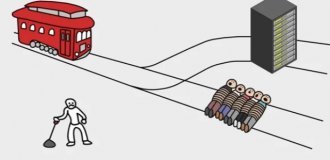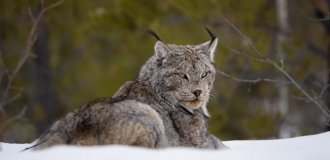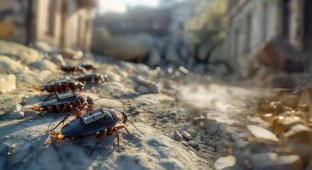Stages of the formation of a swarm of death from locusts: even modern civilization is powerless against the horde (12 photos)
Today we will talk about how little bugs make countries and continents tremble. Why can't anything be done about it? Or is it possible? 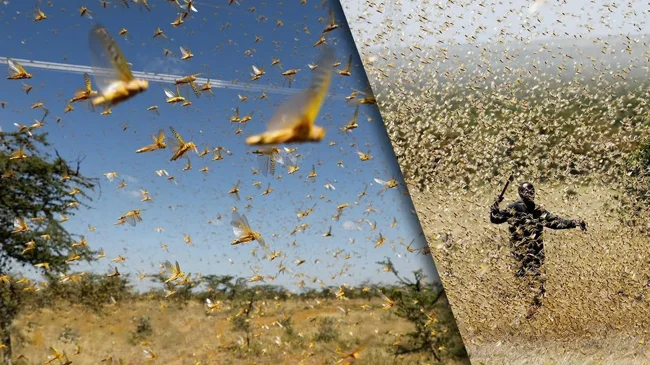
Stage one. Who, where, when?
Who? You will be surprised, but only 30 species of insects are responsible for the Holodomor. So that you understand, there are more than 6,500 representatives in the locust family. But when a voracious swarm literally blocks the sun, people don't care about systematic subtleties. They are ready to attribute even harmless grasshoppers to the villains! Yes, these insects look similar from afar, but up close it is easy to tell them apart: the locust has short antennae, wings lying flat on the back and short legs. The grasshopper has it the other way around - long antennae, house-shaped wings and stilts instead of legs. 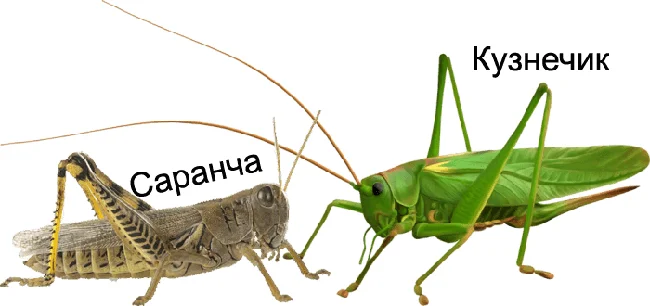
Visual aid: how to tell a bro from a non-bro. 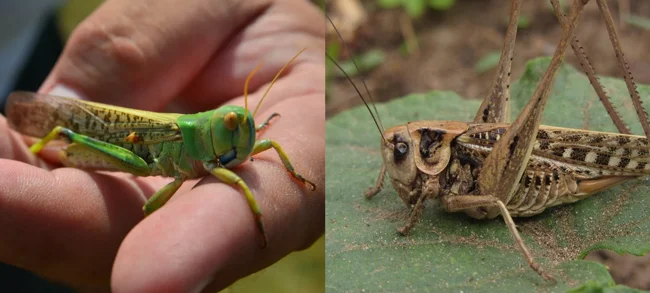
It is definitely impossible to tell a grasshopper from a locust by color! Locusts can also be green, just like grasshoppers can be brown. Here is a clear example.
Where? Specifically here - in the south of the country. For example, in 2015 Kalmykia suffered, and in 2020 - Astrakhan. Alarming data has appeared online this year - a couple of days ago, hordes of voracious creatures were recorded in Dagestan! If we take the world as a whole, then invasions regularly occur in the long-suffering and already hungry Africa, in Asia, on the Arabian Peninsula, in Southern Europe, Australia and America. And if the climate becomes warmer, then perhaps the swarm of death will someday reach our north. This is the answer to the question "when" - usually the invasion occurs in those countries where it is warm enough. At the moment when drought gives way to frequent rains. 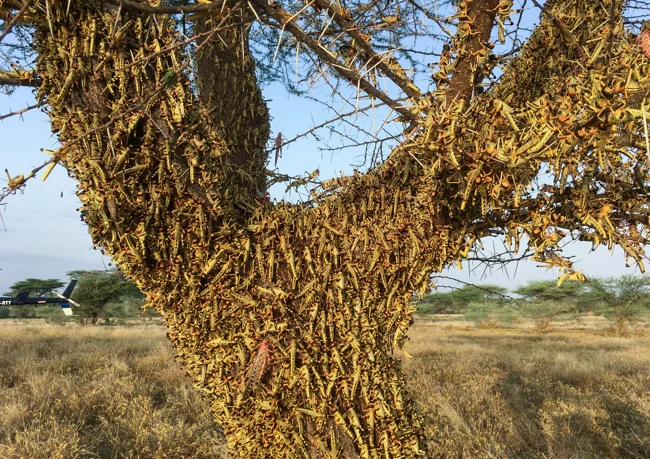
You have strange leaves on your trees in Africa...
Stage two. Why?
In fact, locusts do not have the goal of "arranging an Egyptian plague at any cost." Insects act according to instincts. And the reasons for the formation of a death swarm are incredibly simple - an abundance of food and good weather. That's all they need. However, a hungry cloud does not form in one season. Several years of favorable conditions precede it. 
Somehow everything is too good. They want to make a fuss!
Before they burst into the fields and destroy them completely, locusts live alone. Their life is quiet and almost unnoticeable: the insects eat and reproduce vigorously. The better the conditions, the more offspring the female leaves. And then one day the "point of no return" comes. There are so many locusts that a crush begins, like in a supermarket before the holidays. They touch each other with their antennae, push each other with their hind legs and understand that the time has come. 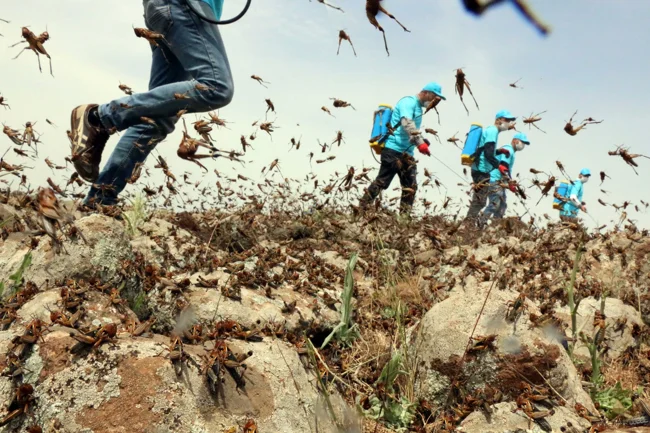
Spraying the swarm manually is almost useless, but in Africa, for example, there are not always funds for airplanes with insecticides.
Stage three. How?
Due to constant tactile contacts with their relatives, locusts produce the hormone serotonin. It brings happiness to humans, but for insects, the release of serotonin is a distress signal. First, the color changes. In young individuals, from camouflage-green to black-orange, and in adults, from brown to bright yellow. 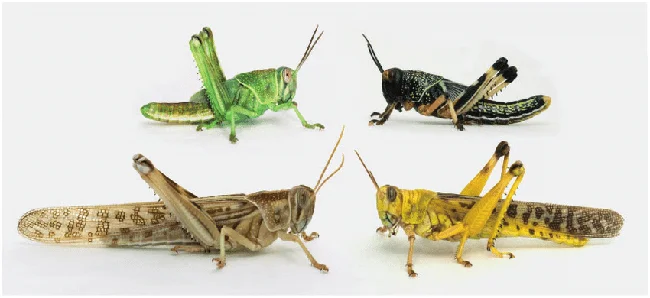
The difference between the solitary form (left) and the gregarious form (right).
Their behavior also changes: the bugs become so indiscriminate in their food that they eat not only plants, but also everything made of them! For example, natural fabrics or ropes. Their brains also grow larger and their endurance increases. Locusts no longer move in short jumps - they are able to cover thousands of kilometers in flight. 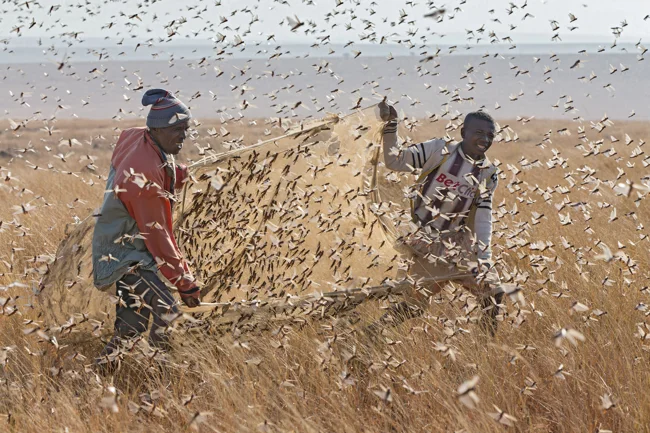
Guys, people are bringing us a gift made of ropes! Hurry up, attack!
This form of insects is called gregarious. It differs from the solitary so much that for a long time scientists considered these stages to be different types of locusts. It is the gregarious form that farmers dream about in their nightmares. It is the one that causes a real apocalypse! The gregarious form of locusts actively synthesizes 4-vinylazinol. This is a pheromone that works like a loudspeaker "everyone here!" Because of this, individuals from all over the area gather in a huge flock and a real Armageddon begins. Each individual is 2 grams of hunger. That is how much it should eat daily. Can you imagine how much a swarm of a billion insects can eat? 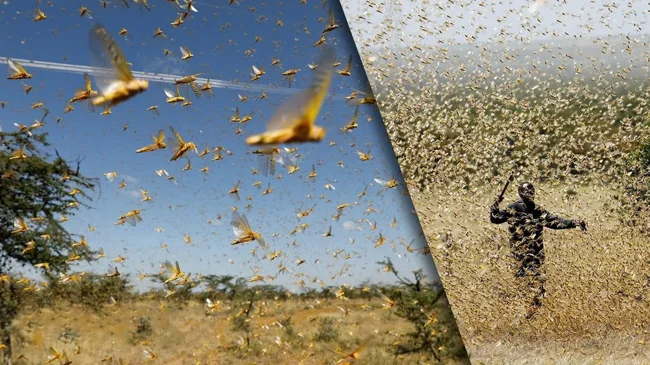
It is useless to chase locusts with a stick. But at least you can vent your anger this way!
The largest locust invasion in history occurred in 1875 in the USA and Canada. According to various estimates, the number reached 12.5 trillion individuals! This is not just a lot, it is a record in the Guinness Book of Records for the largest accumulation of living creatures that has ever existed. This swarm of death was located on 510,000 square kilometers and went from the state of Texas to the northwest, destroying all vegetation in more than 10 states. 1/5 of the country was left without food. 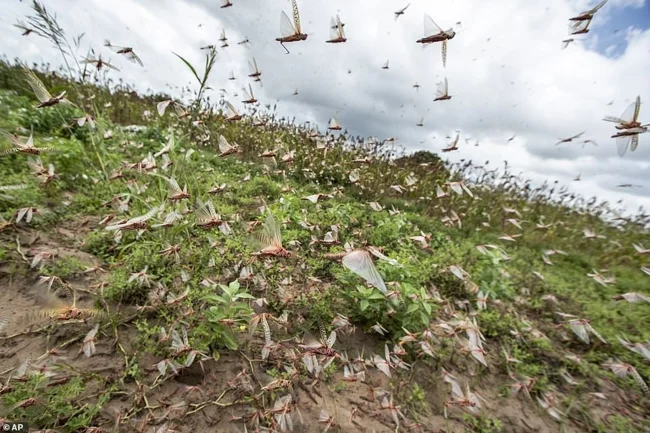
These days, locust invasions are not as large-scale, but they are no less terrifying. In India in 2020, a swarm of 100 billion appeared. In East Africa, there was an invasion of 80 million in the same year. But compared to America, this is child's play.
The travels themselves are also striking in their scale. A hungry swarm can fly over seas and oceans. For example, in 1988, a swarm of locusts crossed from West Africa to the Caribbean in just 10 days. And between them, by the way, there are 5,000 km and the Atlantic Ocean! 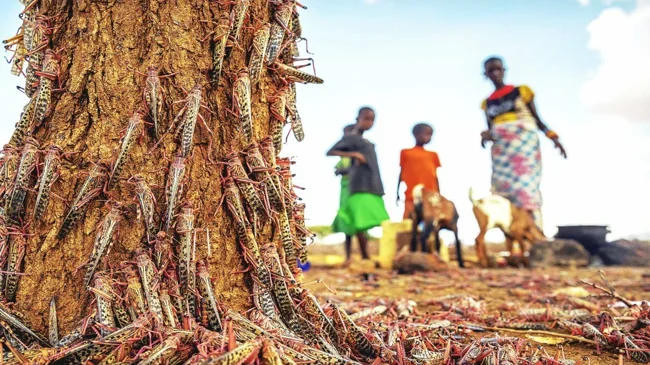
In some countries, locusts are considered a delicacy and are readily eaten. A real feast during the plague.
Stage Five. Endless Horror
Locusts don't just fly and eat everything in their path. During snack stops, insects actively reproduce! During pregnancy, females are affected by hormones and pheromones, so they lay eggs, from which larvae will hatch, which are more prone to swarming. And the circle will close - when the older generation dies of old age, the young will form a new swarm. This is why the fight against locusts is so expensive and ineffective. They breed too quickly and eat too much. Once a swarm is formed and has already taken flight, it is almost impossible to stop it. 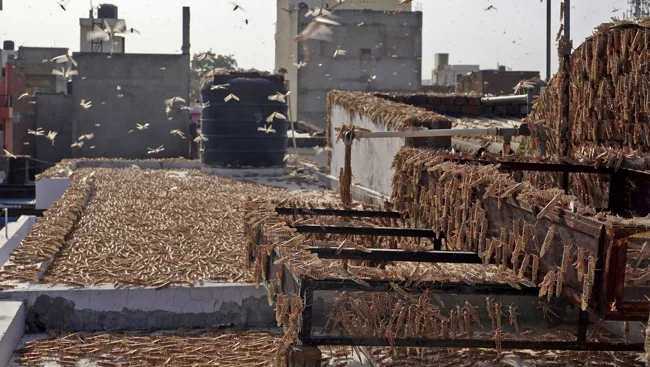
A typical dorm.
The only way for people to somehow avoid starvation after a swarm invasion is to prevent it from appearing. This can only be done at the larval stage, when the locusts have not yet molted and cannot fly. It is necessary to track down mass accumulations of young animals and mercilessly douse them with insecticides, spray predatory fungi that will devour the insects from the inside. You can burn them with a flamethrower, flood them with water, or crush them with a tractor. The main thing is to prevent swarming. The flying apocalypse can cover up to 150 square kilometers in a day - no measures will be enough to stop its deadly march.






